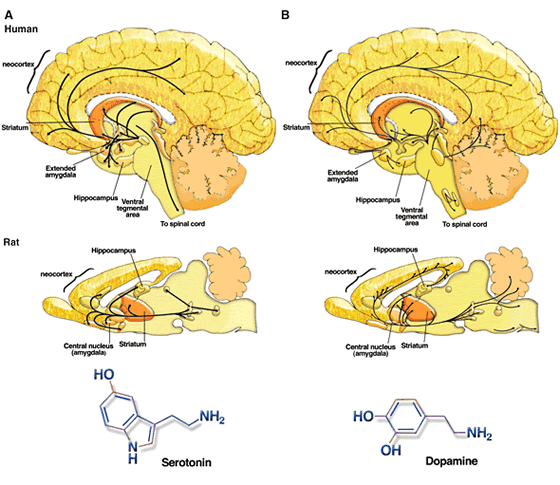Dopamine is a neurotransmitter. It is a chemical messenger that helps in the transmission of signals in the brain and other vital areas. Dopamine is found in humans as well as animals, including both vertebrates and invertebrates.
Dopamine history
Dopamine was first synthesized in 1910 by George Barger and James Ewens at Wellcome Laboratories in London, England.
In 1958, Arvid Carlsson and Nils-Åke Hillarp, at the Laboratory for Chemical Pharmacology of the National Heart Institute of Sweden, discovered the function of dopamine as a neurotransmitter. Arvid Carlsson was awarded the 2000 Nobel Prize in Physiology or Medicine for showing that dopamine is not just a precursor of norepinephrine and epinephrine but a neurotransmitter, as well.
Dopamine production
Dopamine is produced in several areas of the brain, including the substantia nigra and the ventral tegmental area. It is a neurohormone that is released by the hypothalamus. Its action is as a hormone that is an inhibitor or prolactin release from the anterior lobe of the pituitary.

Neurotransmitters with discrete localization within the brain. A) The chemical structure of the monoamine neurotransmitter dopamine and a schematic drawing of the localization of dopamine-containing neurons in the human and rat brain and the sites where dopamine-containing axons are found. B) The chemical structure of the monoamine neurotransmitter serotonin and similar brain map showing locations of serotonin-containing cells and their axons.
Dopamine receptors
Dopamine acts on receptors that are specific for it. Five subtypes of mammalian dopamine receptors are grouped into two classes.
- D1-like receptor class – This comprises of D1 and D5 receptor subtypes
- D2-like receptor class – This comprises of D2, D3, and D4 receptor subtypes
These receptors have similar signalling properties. They however have different signal transduction pathways that determine their subtypes and classes.
All of the dopamine receptors are G protein-coupled receptors (GPCRs), who’s signalling is primarily mediated by interaction with and activation of GTP-binding proteins (G proteins). Members of this superfamily are also called 7-transmembrane receptors because they traverse the cell membrane seven times. They are also called serpentine receptors because of the snake like manner in which they wind back and forth across the membrane.
Actions of dopamine
Dopamine is also used as medication. It acts on the sympathetic nervous system. Application of dopamine leads to increased heart rate and blood pressure.
Dopamine cannot cross the blood-brain barrier, so dopamine given as a drug does not directly affect the central nervous system.
Dopamine is needed in some brain diseases as well. This includes diseases such as Parkinson's disease and dopa-responsive dystonia. For these patients levodopa is used. This is a precursor of dopamine. It can cross the blood-brain barrier.
Further Reading